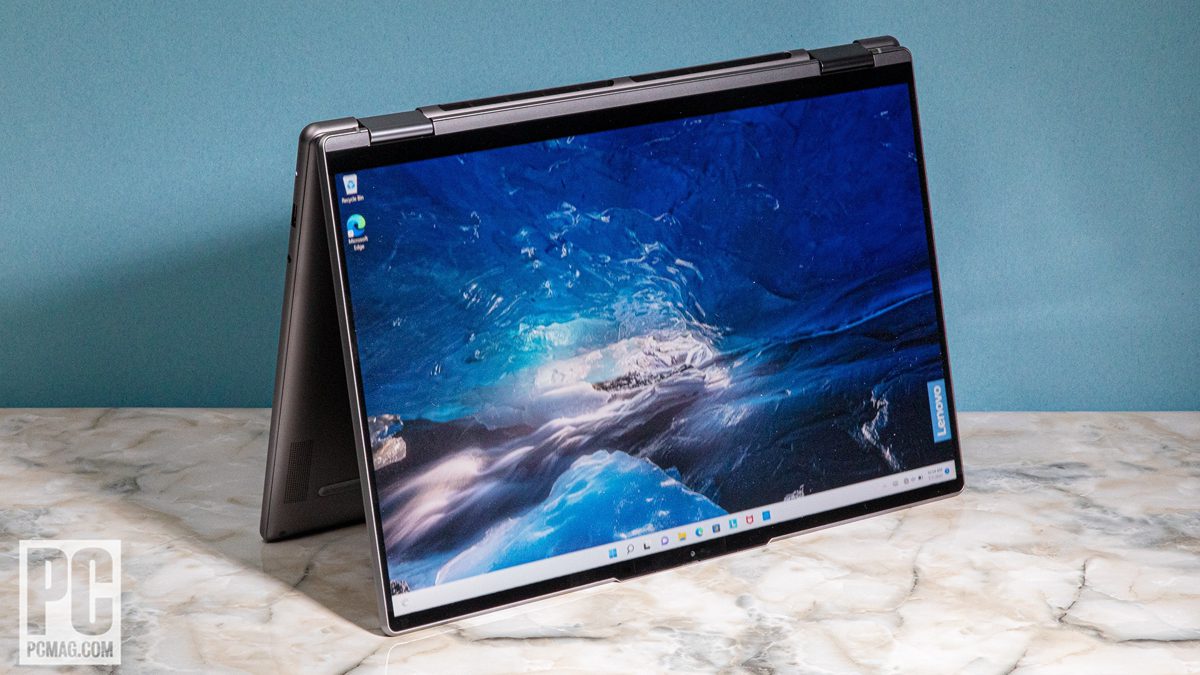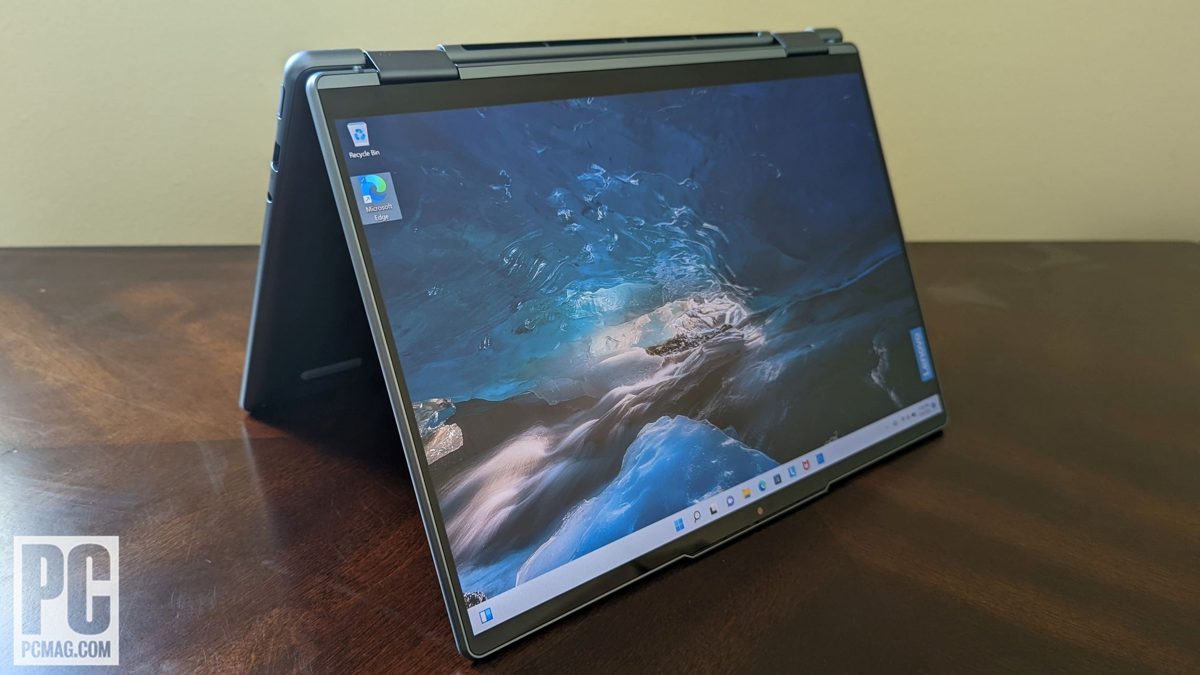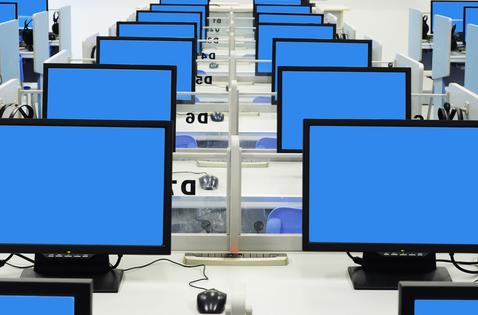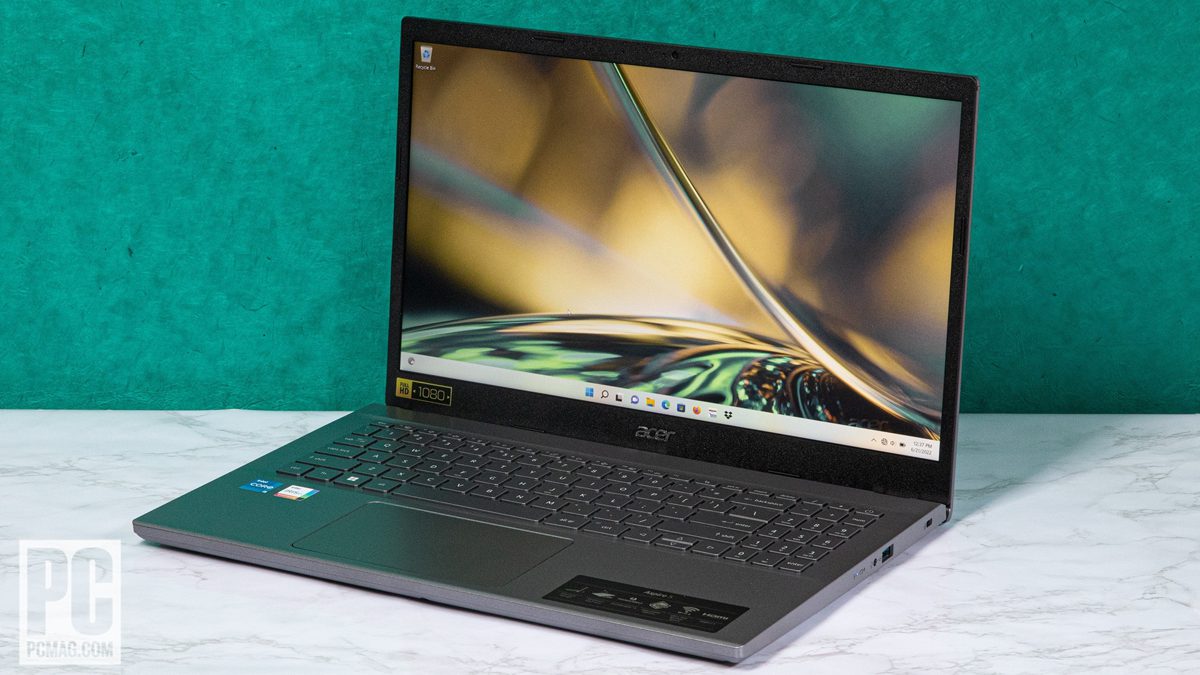As 2-in-1 laptops go, 16 inches is pretty huge. Most convertible laptop/tablet hybrids have screens measuring 12 to 14 inches for more comfortable carrying in tablet mode. A 16-inch tablet isn’t one you’ll use all the time, but a 16-inch desktop replacement laptop that can pivot for presentations or become a tablet for annotating or sketching? That’s a combination that may make more sense, and that’s where the Lenovo Yoga 7i 16 Gen 7 ($1,399.99) comes into the picture. Launching alongside the more mainstream Yoga 7i 14 Gen 7, the bigger model gives users a little more elbow room, a slightly beefier CPU, and a larger battery. It’s got the slick, feature-filled design and rock-solid performance we love about the 14-inch model, but in giant economy size. Bigger may not always be better, but in this case it’s not half bad.
The Biggest Convertible Since Mary Kay’s Cadillac
Like its smaller sibling, the Yoga 7i 16 is available in two colors, Storm Gray and Stone Blue, both anodized shades to dress up the CNC milled aluminum chassis. The Lenovo measures 0.76 by 14.2 by 9.8 inches, more or less matching its 2-in-1 archrival the HP Specter x360 16 (0.78 by 14.1 by 9.7 inches), but is lighter—the Lenovo tips the scale at 4.19 pounds to the HP’s 4.45.

Our $1,399.99 review unit combines Intel’s 12th Generation Core i7-1260P processor (four Performance cores, eight Efficient cores, 16 threads) with 16GB of LPDDR5 memory, a 512GB PCIe 4.0 solid-state drive, and a glossy IPS touch screen with 2,560-by -1,600-pixel resolution and 400 nits of brightness. No other screen is available (ie, you can’t match the Specter x360 16’s OLED panel), but other models at Lenovo.com offer a 4GB Intel Arc A370M GPU instead of our unit’s Iris Xe integrated graphics.
There are a few design changes that come with the increase in bulk from the Yoga 7i 14 to the 7i 16. The wider chassis provides room for a compact numeric keypad squeezed in at the right of the keyboard. The keys of the number pad are a little narrower than the primary keys, but not so much that they feel cramped when entering spreadsheet data.

Another change is a different position for the speakers, with a speaker grille between the screen and keyboard. With four stereo speakers, two 3-watt woofers, and dual 2-watt tweeters, the sound offered by the 16-inch laptop is superb, with robust volume and great clarity. It’s enhanced with Dolby Atmos support and automatic amplification.
Given the slim, streamlined design of the Yoga 7i 16, the convertible offers an impressive selection of ports. It’s a welcome departure from the current minimalist chic that relies on just a few Thunderbolt 4 ports plus adapters or dongles, for most ports, and it makes the Yoga 7i a versatile choice for users on the go. On the left, you’ll find an HDMI video output, two USB Type-C/Thunderbolt 4 connectors, a USB 3.2 Type-A port, and a full-size SD card slot.

On the right are a 3.5mm headphone jack and a second USB-A port, along with the power button. The Lenovo also has up-to-date wireless support, with Wi-Fi 6E in lieu of Ethernet and Bluetooth 5.2 for quick connections to peripherals and audio devices.

The Display: Skinny Screen Sides, With a Bump
The 16-inch touch screen looks great, with crisp details thanks to 2,560-by-1,600 resolution, good contrast, and full support for both touch and active pen. (Unfortunately there’s no pen in the box.) But it’s all the more impressive when you stop to notice the slim bezels around the display—if you don’t look for them, you might miss them completely, since Lenovo boasts the laptop has a 91% screen-to-body ratio in tablet mode.
It’s also impressive that despite the narrowness of the screen borders, you never feel like you’re missing a place to hold the Yoga when in tablet mode—the rounded edges of the chassis provide enough of a finger and thumb grip to hold on comfortably without encroaching on the display real estate.

Above the screen is the slight protrusion of what Lenovo calls the communications bar, the housing for the 1080p webcam, dual microphones, and Windows Hello-compatible IR face recognition sensors for the laptop. It’s sort of a reverse approach to Apple’s infamous notch, raised above the display instead of dipping down into it. There’s a sliding privacy shutter for the webcam (although it’s so small you might not notice it) and the bar itself provides a handy ridge to help you open and close the lid despite the smoother rounded corners.
Performance Testing the Yoga 7i 16: A High-End Laptop Contest
For our benchmark charts, we matched the Yoga 7i 16 Gen 7 against two other 16-inch deluxe notebooks, the directly competing HP Specter x360 16 convertible and the AMD-powered Asus Vivobook Pro 16X OLED. We also compared it to another plus-size convertible, the 15-inch, business-oriented Dell Latitude 9520 2-in-1.
Our main productivity benchmark for Windows systems is UL’s PCMark 10, which simulates everyday tasks like word processing, spreadsheet analysis, web browsing, and videoconferencing. We also run PCMark 10’s Full System Drive test to assess the responsiveness and throughput of a laptop’s boot drive. Geekbench 5 is another test that simulates popular apps including PDF rendering and speech recognition with a bit more of a focus on processing power.
Two other CPU-intensive benchmarks that stress all available cores and threads are Maxon’s Cinebench R23, which uses that company’s Cinema 4D engine to render a complex scene, and the open-source video transcoder HandBrake, which we use to convert a 12-minute clip of 4K video to 1080p resolution (lower times are better). Our final productivity test is workstation vendor Puget Systems’ PugetBench extension for Adobe Photoshop, which uses the Creative Cloud 22 version of the famous image editor to execute a variety of general and GPU-accelerated tasks ranging from opening, rotating, and resizing an image to applying masks, gradient fills, and filters. Like HandBrake, the test rates a PC’s suitability for digital content creation and multimedia jobs.
All of these systems sailed past the 4,000-point mark in PCMark 10 that indicates excellent productivity for the likes of Microsoft Office and Google Workspace, but they swapped victories in specific benchmarks, with the Asus claiming most of the CPU honors but the Yoga 7i 16 winning in Geekbench. The bigger picture shows that they’re all high-performance productivity and creative machines.
We test PCs’ graphics capabilities with two game-like animations a piece from two benchmark suites. The DirectX 12 tests Night Raid (more modest, suitable for laptops with integrated graphics) and Time Spy (more demanding, ideal for gaming rigs with discrete GPUs) hail from UL’s 3DMark, while GFXBench contributes the 1440p Aztec Ruins and 1080p Car Chase subtests, rendered off-screen to accommodate different display resolutions. The latter two tests focus on high-level image rendering and low-level routines like texturing respectively.
The HP and Asus dominated these tests, which was predictable since they have discrete Nvidia GeForce GPUs that outperform both the Dell’s 11th Gen and the Lenovo’s 12th Gen Intel integrated graphics.
Finally, we test laptops’ battery life by looping a locally stored 720p video file (the open-source Blender movie Tears of Steel) with display brightness at 50% and audio volume at 100%. We make sure the battery is fully charged before the test, with Wi-Fi and keyboard backlighting off. We also use a Datacolor SpyderX Elite monitor calibration sensor and software to measure the screen’s color saturation—what percentage of the sRGB, Adobe RGB, and DCI-P3 color gamuts or palettes the display can show—and its brightness in nits (candelas per square to put).
The Lenovo’s battery life was impressive, exceeding 18 hours in our video rundown. That outlasted the Dell by nearly two hours and crushed the runtimes of the OLED-screened Asus and HP. Those systems got their revenge in our color coverage measurement, showing more vivid hues and spanning virtually all of the various gamuts compared to the laptops with IPS panels. The Yoga 7i’s screen brightness was a little lower than we like to see in a high-end notebook (the same number of nits look more brilliant with an OLED rather than IPS display), but perfectly acceptable. The screen supports Dolby Vision HDR, reserving max brightness for smaller portions or application windows rather than the full screen that our test measures.
Verdict: More Room to Maneuver, If You Want It
Generally speaking, 15.6-inch and 16-inch convertible laptops are awfully unwieldy for use as tablets, but they shine when pivoted to easel or kiosk more for presentations and can take touch interaction further than a smaller notebook. If your budget permits we prefer the HP Specter x360 16’s dazzling OLED display, but the Lenovo Yoga 7i 16 Gen 7 is a great alternative and a superbly well-made solution for anyone seeking a larger 2-in-1.
.



















